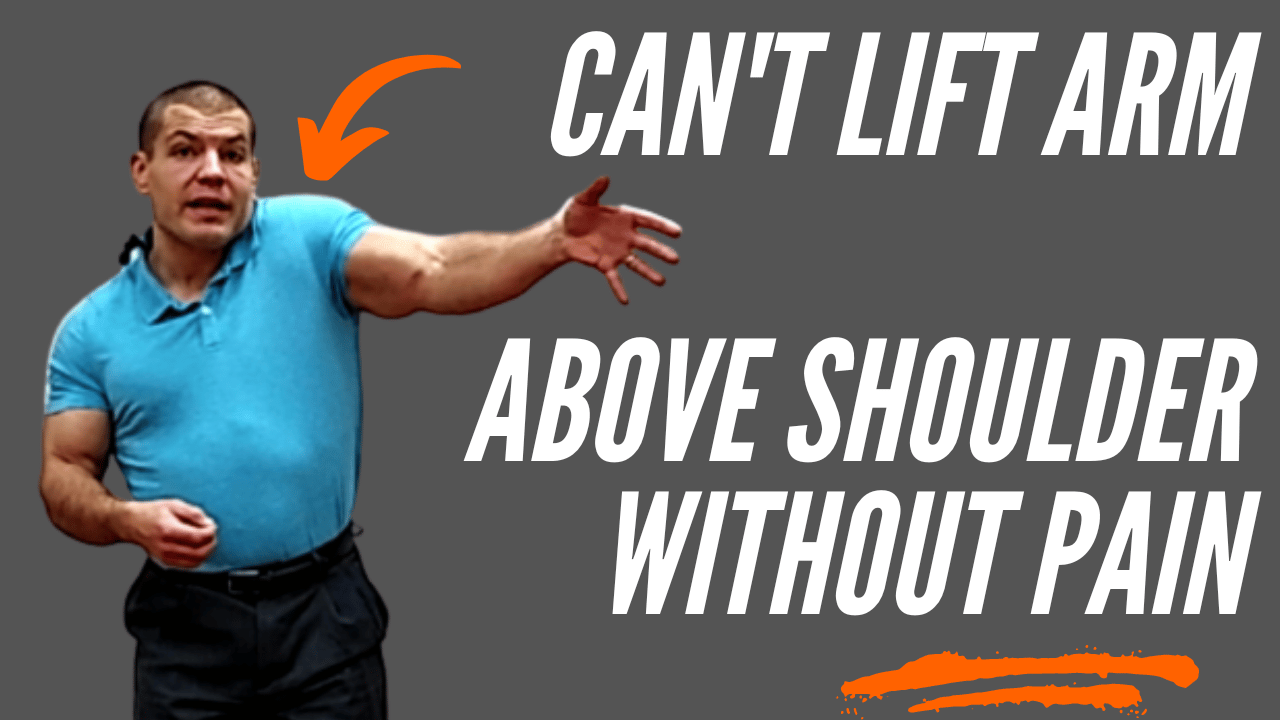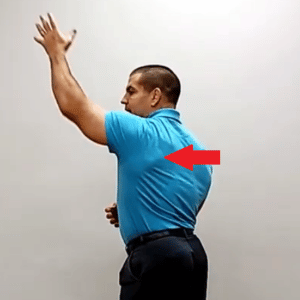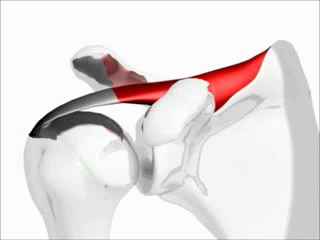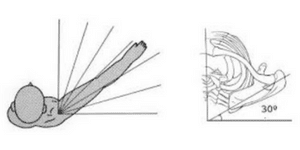What Can I Do If I Can't Lift My Arm Above My Shoulder Without Pain?
Whether you just can't lift your arm above your shoulder without pain, or if you can't lift your arm above your head at all, the tips in this video can help you raise your arm more comfortably.

What Does It Mean If I Can't Lift My Arm Above My Shoulder Without Pain?
There are a number of things that can give you trouble lifting your arm above shoulder. Some of these things cause shoulder pain when lifting your arm, and others aren't painful at at all.
These things fall into a few categories:
- You can lift your arm above shoulder level, but it hurts
- You can't lift your arm above shoulder and it hurts
- You can't lift your arm above shoulder level but there's no pain
What Causes Pain When Lifting Arm Above Shoulder Level?
If you're able to lift your arm above your shoulder but it hurts, that's the least serious case.
Some things that can cause pain lifting your arm above shoulder level include:
- Rotator cuff tendonitis or tendinopathy
- A labral tear in your shoulder
- Shoulder bursitis
Regardless of which of these things are the cause of the pain when lifting your arm, the tips below can help with all of those problems.
Tips To Relieve Pain When Lifting Arm Above Shoulder
Tip #1: What to do if you can't lift your arm straight out in front
If you can't lift your arm straight out in front of you without pain, making slight changes to the way that you reach can help you relieve your shoulder pain.
When you reach forward with your arm straight, it creates a lot of torque on your shoulder muscles, including your rotator cuff muscles. This can cause pain especially if you have a rotator cuff problem. The fact that you ARE able to lift your arm makes it unlikely that the rotator cuff is completely torn, but it may still hurt to move it.
Instead of reaching straight out the the front, think about reaching in a up and forward motion.
Start with your elbow bent and then gradually straighten you elbow as you reach up and forward. This shortens the lever arm of the lifting motion and means your rotator cuff muscles won't have to work as hard.
See the video above for specific instructions on how to do this.
For more information on how to strengthen your rotator cuff, check our our post on exercises for a rotator cuff injury.
Additionally, when you reach up and forward, it allows your shoulder blade to move properly.
When you lift your arm above your head, 2/3 of the movement should come from the ball-and-socket joint of the shoulder itself, but 1/3 of the movement comes from your shoulder blade moving on your trunk.
When you reach in an up and forward motion, it allows the shoulder blade to move correctly so that the socket of the shoulder faces more upward.
Tip #2: Thumbs up for success when lifting arm above shoulder
How you position your thumb when you lift your arm above shoulder level can affect how much pain you have.
As seen in the picture below, your shoulder is a ball and socket joint, but the ball of the shoulder isn't a perfectly round ball.
If the ball isn't positioned correctly in the socket, the bumps on the "ball" of the shoulder can pinch the rotator cuff tendons on the arch of bone and tendons that lies over the top of the shoulder.
If you reach upward with your thumb up, this puts the shoulder in external rotation and moves the bump (greater tuberosity) on the ball of the shoulder out from under the arch of the shoulder.
This in turn prevents pinching of the rotator cuff tendons as you raise your arm.
Think "Thumbs up is good. Thumbs down is bad."
Tip #3 What to do if you can't lift your arm out to the side without pain
Reaching out to the side is somewhat of an unnatural motion.
Your shoulder blades normally sit in an angle on your trunk (about 30 degrees) as shown below:
Therefore the natural motion of lifting your arm is slightly in front of the body.
This makes sense functionally because we normally move our arms to reach for things in front of use.
If you have pain lifting your arm out to the side, one solution is to turn your body to face toward what you're reaching for whenever possible.
However, sometime it is helpful to do be able to reach out to the side. Some examples include:
- Reaching for something on your bedside table.
- Doing lateral raise exercises
- Reaching into the back seat of the car
If you are going to lift your arm out to the side here are some suggestions to make it less painful.
- Use thumb up instead of palm down as noted above
- Reach slightly in front of straight out to the side as shown above.
- If you are going to reach straight out to the side, squeeze your shoulder blades back together so the socket of the shoulder is straight to the side.
Need Help For Shoulder Pain When Lifting Your Arm?
Request a Free Discovery Visit to learn how we can help your shoulder pain
Can't Lift Arm Above Shoulder And It Hurts?
What if you just can't lift your arm above shoulder level at all?
If you can't lift your arm above shoulder level and have pain when attempting to do so, then there's a chance you could have a rotator cuff tear. There's also the chance that you could have a frozen shoulder.
So how do you tell the difference?
Well, a rotator cuff tear is a tear in a muscle, which creates a force production problem.
If you can use your other arm to lift the painful are above your head but you can't move the arm under it's own power, chances are it's a rotator cuff tear.
Rotator cuff tears come in various sizes:
Small - you usually CAN move your arm in a normal range of motion but you may have some pain. These usually don't require surgery.
Medium to Large - you may have some limited motion and pain. These sometimes require surgery depending on what activities you need to get back to.
Complete Rupture - if the rotator cuff is torn completely, you won't be able to move your arm, but may not have pain either because the two ends aren't connected. (See the next section)
What about a frozen shoulder?
If you can't lift your arm on it's own, and you also can't lift it overhead using your other arm to help, there's a possibility you could have a frozen shoulder.
A frozen shoulder creates a stiff, painful shoulder.
Learn more about frozen shoulders here.
Can't Lift Arm Above Shoulder But It Doesn't Hurt?
If you can't lift your arm but you don't have pain doing it, you could have a complete rupture of your rotator cuff as mentioned above.
Many times people elect not to have surgery for this type of problem particularly if they're older and don't use their arm that much. If they're not having pain, it may not be worth it for them to have a painful rotator cuff surgery and then have to undergo rehab afterward if their shoulder isn't hurting in the first place. In this case, physical therapy can help improve the function of the remaining intact muscles.
Pinched Nerve In Neck
If you can't lift your arm and it doesn't hurt, it could also be caused by a nerve problem. A pinched nerve in your neck can cause painless weakness of your arm.
The C5 nerve innervates the shoulder, and a pinched C5 nerve is the most common nerve root in the neck associated with of weakness lifting the arm.
In either event, if you absolutely CAN'T lift your arm above shoulder level (with or without pain), it's worthwhile getting it checked out by a physical therapist experienced in treating shoulder problems.
Need Help Lifting Your Arm?
Talk to one of our Specialists to learn how we can help.
Like this post? See our other posts on Shoulder Pain
Help! My Shoulder Hurts After Sleeping






